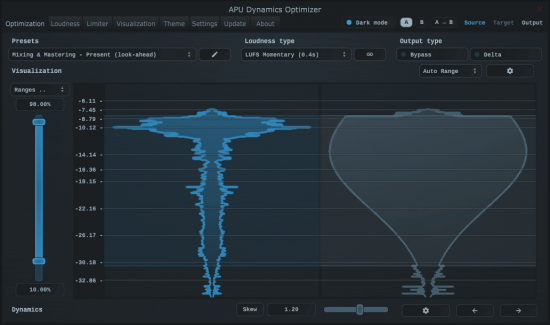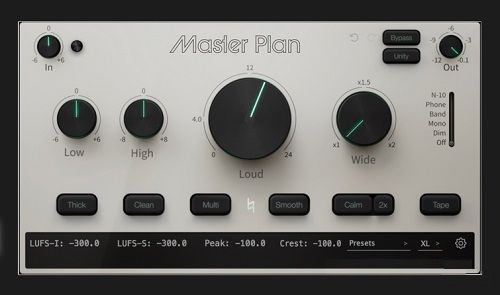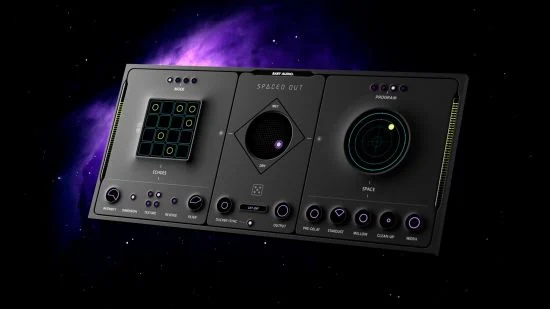
Win/macOS | File size: 22.2 MB
APU动态优化器是一个动态优化工具,旨在支持现代响度类型(LUFS,真峰)。在引擎盖下,优化器使用与APU响度压缩器相同的压缩引擎,但受益于完整的音频波形,而不是实时测量。这使得增益包络线可以在整个波形中进行精心优化。
该工具的设计允许您非常精确地针对特定的平均LUFS和动态范围。一旦增益包络得到优化,您就可以实时回放结果,同时使用压缩机插件的相同参数集合调整声音的特征。
预排
当您第一次打开音频文件时,优化器将分析音频文件的响度时间轴。然后你会看到一对直方图。在左侧,您将看到音频文件的当前响度分布。在右边,你会看到一个目标分布。优化器的工作是在整个音频文件中动态压缩和扩展音频,以匹配目标分布。
在继续下一步之前,可以对源百分位数进行调整。这允许你从优化过程中排除任何不需要的音频。默认情况下,将百分位数设置为与LUFS中的LRA标准相匹配。这通常能够很好地捕捉音频的主体内容。
一旦您对源百分位数范围感到满意,就可以按右箭头继续下一步。
优化完成后,您可以实时播放结果,同时使用来自压缩器插件的相同参数集合调整声音的特征。使用播放/停止按钮和搜索滑块来导航音频,同时进行任何调整。
一旦你对结果感到满意,你就可以将优化的音频导出到一个新文件中。该文件始终存储与原始音频相同的采样,使用32位浮点波格式。这确保了最高质量的音频被保留。这种格式还允许超过0 dBFS的样本,从而确保不会发生裁剪。
您可以收听和导出有或没有限制。内置限制器可以在限制器选项卡中配置,或者您可以完全绕过限制器,并在导出后使用自己的外部限制器。
动力学影响
动态优化器允许您重塑您的音频文件的完整动态频谱。您可以在均匀分布或正态分布之间进行选择,并能够将后者向分布的顶部或底部倾斜。这允许你以各种方式塑造你的音频动态。优化器获取这些信息,并使用它对压缩/展开比进行许多微小的调整。这是你用传统压缩机永远无法做到的。
可以将优化器配置为使用以下分发类型
统一的
均匀分布类型是在整个响度范围内的平坦分布。对于大多数音频文件来说,这是一个很好的起点,因为它不支持任何特定的响度范围。结果是一个非常平衡的响度轮廓。
正常的
正态分布类型是钟形曲线分布,可以向分布的顶部或底部倾斜。这允许你选择一个非常特殊的形状,无论是为了更接近原始音频还是为了创造效果。
The APU Dynamics Optimizer is a dynamics optimization tool designed to support modern loudness types (LUFS, True Peak). Underneath the hood, the optimizer uses the same compression engine as the APU Loudness Compressor, but benefits from the full audio waveform instead of real-time measurements. This allows the gain envelope to be meticulously optimized across the entire waveform.
The design of this tool allows you to very precisely target a specific average LUFS and dynamic range. Once the gain envelope has been optimized, you can playback the result in real-time while adjusting the character of the sound with the same collection of parameters from the compressor plug-in.
Walkthrough
When you first open an audio file, the optimizer will analyze the audio file’s loudness timeline. You’ll then be presented with a pair of histograms. On the left, you’ll see the audio file’s current loudness distribution. On the right, you’ll see a target distribution. The optimizer’s job is to dynamically compress and expand the audio throughout the entire audio file strategically to match the target distribution.
Before continuing to the next step, you can make adjustments to the source percentiles. This allows you to exclude any unwanted audio from the optimization process. By default, the percentiles are set to match the LRA standard from LUFS. This generally does a good job capturing the main body of the audio.
Once you’re happy with the source percentile range, you can then press the right arrow to continue to the next step.
Once optimization is complete, you can play the result in real-time while adjusting the character of the sound with the same collection of parameters from the compressor plug-in. Use the play/stop buttons and seek slider to navigate the audio while making any adjustments you’d like.
Once you’re happy with the result, you can export the optimized audio to a new file. This file is always stored with the same samplerate as the original audio, using 32-bit floating point wave format. This ensures the highest quality audio is preserved. This format also allows samples over 0 dBFS, which ensures no clipping occurs.
You can listen and export with or without limiting. The built-in limiter can be configured in the Limiter tab, or you can bypass the limiter entirely and use your own external limiter after export.
Dynamics shaping
The dynamics optimizer allows you to reshape the full dynamics spectrum of your audio file. You can choose between Uniform or Normal distribution, with the ability to skew the latter toward the top or bottom of the distribution. This allows you to shape the dynamics of your audio in a variety of ways. The optimizer takes this information and uses it to make many tiny adjustments to the compress/expand ratio over time. Something you’d never be able to do with a traditional compressor.
The optimizer can be configured to use the following distribution types
Uniform
Uniform distribution type is a flat distribution across the entire loudness range. This is a good starting point for most audio files, as it doesn’t favor any particular loudness range. The result is an extremely balance loudness profile.
Normal
Normal distribution type is a bell curve distribution which can be skewed toward the top or bottom of the distribution. This allows you to dial in a very particular shape of your choosing, whether it’s to more closely match the original audio or for creative effect.
Homepage






